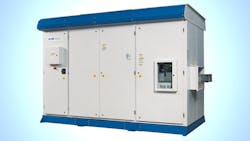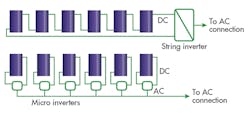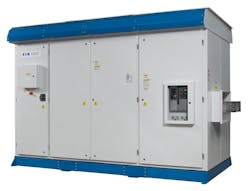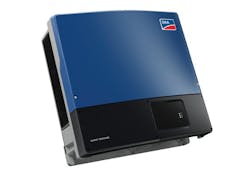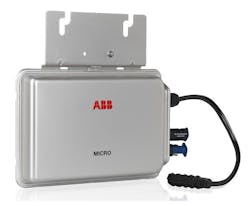Is the Electrical Grid Keeping Up with Smart Solar Inverters?
This file type includes high-resolution graphics and schematics when applicable.
Within the fast-growing solar-energy market, solar-inverter suppliers must keep pace with electronic technology advances in order to deliver more efficient and reliable parts at a lower cost. Inverter efficiency indicates the percentage of the available solar power that’s actually converted by the inverter and fed into the utility grid; some smart inverters reach a total efficiency of 98%. To achieve high efficiency, it’s important to design the inverters using the most reliable components from power semiconductors (MOSFETs and/or IGBTs), capacitors (electrolytic capacitors, high-capacity film capacitors), transformers, cooling systems, etc.
An inverter is a highly demanding power electronic device. Recognizing the smart inverter’s vital role in the solar renewable-energy market, ABB announced the creation of a multimillion-dollar facility with a utility-scale solar-inverter testing laboratory earlier this year.
The laboratory features a unique, large climate chamber capable of full power electrical testing in simulated conditions ranging from the arctic tundra to an equatorial rainforest. The chamber also allows for accelerated product testing, which is important when the inverters are typically expected to operate for more than 20 years. The laboratory that opened in Helsinki supports the following: testing and verification of inverters for safe operation; compatibility to the most demanding renewables-specific-grid code requirements; and the measurement and testing of harmonics and grid interactions.
Europe has been working on grid modernization for quite a while and the United States is taking the first steps toward the implementation of a smart grid. Early this year, U.S. Secretary Ernest Moniz announced that the Energy Department’s (DoE) Grid Modernization Initiative would improve the resiliency, reliability, and security of the nation’s electrical power grid.
For example, the DoE announced $18 million in funding for six new projects across the United States. It said that the six new integrated photovoltaic (PV) and energy storage projects will utilize Internet-capable inverters, working with smart buildings, smart appliances, and utility communication and control systems. The results developed under this effort will enable the sustainable and holistic integration of hundreds of gigawatts of additional solar energy onto the electric grid throughout the U.S.
Internet-capable inverters or smart inverters have a digital architecture with bidirectional communications capability and robust software infrastructure to provide the following functionalities to improve the grid:
• Remote ON/OFF: Smart inverters can connect/disconnect from the grid.
• Power factor control: Smart inverters allow rising or sinking the reactive power by setting the ratio of real power to apparent power.
• Reactive power control: Smart inverters set the level of reactive power generation or consumption.
• Volt/reactive power management: Smart inverters provide voltage regulation by modulating reactive power output.
• Volt/real power management: Smart inverters provide voltage regulation by modulating real power output.
• Frequency/watt management: Smart inverters allow distributed energy resources (DER) systems to help with frequency regulation by changing its real power output.
• Low/high voltage and frequency ride-through: Smart inverters can remain connected to the grid and adjust their output to operate at high/low frequencies and under zero-, low-, and high-voltage ride-through conditions.
• Power curtailment: Smart inverters specify an upper limit for inverter active-power output to reduce the array’s power output.
Solar inverters, also known as grid-tie inverters, may be classified as string inverters, central inverters, and micro-inverters (Fig. 1):
• A string inverter is the type most commonly used in applications up to 100 kW, such as home and commercial solar PV systems where a maximum-power-point-tracking (MPPT) system captures the maximum energy from the PV panel.
• Central inverters are designed for applications above 100 kW, such as large arrays installed on buildings, industrial facilities, and field installations.
• A micro-inverter is a string inverter with a MPPT module placed to capture every panel, optimizing each solar panel instead of the entire solar PV system—much like central inverters but at a lower power (typically 300 W).
Are micro-inverters better than string inverters, though? The answer isn’t a simple yes or no. It depends on so many factors: number of panels, shading issues, operating temperature range, maintenance costs, longer warranties, system monitoring options, future system expansions, etc. The main advantage of micro-inverters is that they can isolate a panel without affecting the system’s overall performance, plus they’re easy to fix. On the other hand, string inverters offer an initial lower cost-per-peak-watt price and are easier to install.
Smart-Inverter Examples
Most inverters in operation in the U.S. are IEEE1547 and UL 17451 certified. Some have smart functionalities built-in, but are disabled in order to comply with present standards and rules. Let’s take a look at some smart-inverter examples/products currently on the market that could meet future grid-support functionality.
In industrial facilities, the centralized architecture offers the best levelized cost of electricity (LCOE). Eaton Corp., a power-management company, offers its Power Xpert Solar Inverter (Fig. 2). Built for the utility-scale class, it features a large power block inverter (1.5 MW and 1.67 MW). The Power Xpert is made up of conservatively designed critical components (magnetics, IGBTs, capacitors, dc switches, and ac breakers) and a wide MPPT voltage range (500-1000 V dc) that maximizes inverter operation time. It’s rugged and robust design is outdoor-rated; no extra shelter is needed.
The Power Xpert Solar Inverter is certified by Intertek per UL174 and complies with IEEE 1547 (total harmonic distortion at rated power) with a maximum inverter efficiency of 98%. Like many other inverters, this grid-tied inverter also offers grid-management features: low- and high-voltage ride-through (LVRT and HVRT), frequency ride-through (FRT), voltage control, frequency-droop control, power-ramp control, islanding detection, etc.
SMA offers a string inverter applicable for 1000 V dc in decentralized commercial applications, allowing for the creation of longer strings. The SMA Sunny Tripower 30000TL-US (Fig. 3) is a 30-kW, three-phase transformerless inverter with a peak efficiency of above 98% with two independent MPP trackers feeding an eight-string and OptiTrac Global Peak for shade mitigation. It includes emerging interconnection requirements, such as the recent revisions to California's Rule 21 and HECO's transient overvoltage and ride-through requirements, and it complies with the National Electrical Code’s (NEC) new Section 690.12—Rapid Shutdown of PV Systems on Buildings.
Lately, micro-inverters have seen a rise in popularity even though it’s not a new technology and they cost more per peak watt than string inverters. That’s because they’ve become a solution for inverters in residential and commercial applications where every panel can be individually controlled. ABB’s MICRO inverter (Fig. 4), at 0.25 to 0.3 kW, promises to reduce shading and mismatching effects with a maximum efficiency of 96.5%. With a precise MPPT algorithm and outdoor enclosure, it complies with Safety and EMC standards.
Conclusion
Solar inverters represent the heart of solar-power systems. Utilities are seeing their value and, therefore, solar-inverter products will keep advancing while significantly contributing to the modernization of the electrical power grid. In the United States, equipment standards, safety standards, and current grid codes need to be updated to roll out smart inverters at their fullest potential.
Looking for parts? Go to www.SourceESB.com.
About the Author
Maria Guerra
Power/Analog Editor
Maria Guerra is the Power/Analog Editor for Electronic Design. She is an Electrical Engineer with an MSEE from NYU Tandon School of Engineering. She has a very solid engineering background and extensive experience with technical documentation and writing. Before joining Electronic Design, she was an Electrical Engineer for Kellogg, Brown & Root Ltd (London. U.K.). During her years in the Oil and Gas Industry she was involved in a range of projects for both offshore and onshore designs. Her technical and soft skills bring a practical, hands-on approach to the Electronic Design team.
